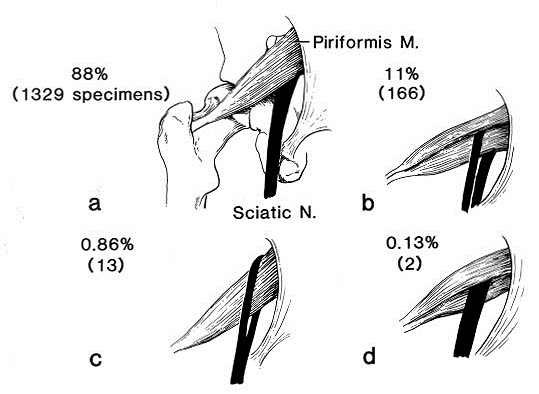FAIR test
Original Editors - Marlies Verbruggen
Top Contributors - Sheik Abdul Khadir, Marlies Verbruggen, Adam Vallely Farrell, Kim Jackson, WikiSysop, Melissa Decoen, Evan Thomas, Vidya Acharya and Wanda van Niekerk
Definition / Description[edit | edit source]
The FAIR test is a sensitive and specific test for piriformis syndrome. FAIR stands for flexion, adduction and internal rotation. Also known as piriformis test. Piriformis Test Piriformis Syndrome
Background[edit | edit source]
Number of extremities studied, 1510 [1]
A: Usual relationships with the sciatic nerve passing from the pelvis beneath m. piriformis.
B: M. piriformis divided into two parts with the peroneal division of the sciatic nerve passing between the two parts of piriformis.
C: The peroneal division of the sciatic nerve passes over m. piriformis and the tibial division passes beneath the undivided muscle.
D: In these cases, the entire nerve passes through the divided m. piriformis.
Technique[edit | edit source]
The patient is lying on the uninvolved side, with the affected side up hereby is the hip flexed to 60 degrees and the knee to 60 à 90 degrees. The examiner stabilizes the hip and applies downward pressure to the knee to internally rotate and adduct the hip,[2] [3] thus placing the piriformis on a stretch that compresses the sciatic nerve.
Variation[edit | edit source]
The FAIR test can be performed with the patient supine or seated, knee and hip flexed, and hip medially rotated, while the patient resists examiner attempts to externally rotate and abduct the hip.
The FAIR test result is positive if sciatic symptoms are recreated. [4][5][6][7][8]
Evidence Based[edit | edit source]
The FAIR test correlates well with a working definition of piriformis syndrome, based on prolongation of the H-reflex with hip flexion, adduction, and internal rotation (FAIR) and is a better predictor of successful physical therapy and surgery than the working definition. The FAIR test, coupled with injection and physical therapy and/or surgery, appears to be effective means to diagnose and treat piriformis syndrome. [8]
References[edit | edit source]
- ↑ From Beaton, L.E. and B.J. Anson. The relation of the sciatic nerve and its subdivisions to the piriformis muscle. Anat. Rec. 70:1-5, 1938
- ↑ Kirschner JS, Foye PM, Cole JL. Piriformis syndrome, diagnosis and treatment. Muscle Nerve Jul 2009 ; 40(1) : 10-18
- ↑ Lori A, Boyajian- O’ Neill et al. Diagnosis and Management of Piriformis syndrome : an osteopathic approach. The journal of the American and osteopathic association Nov 2008; 108(11): 657-664.
- ↑ Pace JB, Nagle D. Piriformis syndrome. West J Med. 1976; 124: 435-439.
- ↑ Foster MR. Piriformis syndrome. Orthopedics. 2002; 25: 821-825
- ↑ Benzon HT, Katz JA, Benzon HA, Iqbal MS. Piriformis syndrome: anatomic considerations, a new injection technique and a review of the literature. Anesthesiology. 2003; 98: 1442-1448.
- ↑ Magee DJ. Orthopedic physical assessment. 3rd ed. Philadelphia. Pa: WB Saunders Co; 1997
- ↑ 8.0 8.1 Fishman LM, Dombi GW, Michaelsen C, Ringel S, Rozbruch J, Rosner B, et al. Piriformis syndrome: diagnosis, treatment and outcome- a 10 year study (review) Arch Phys Med Rehabil. 2002; 83: 295-301.







